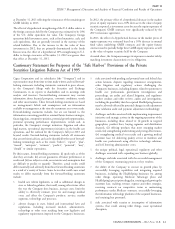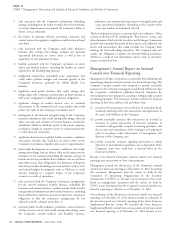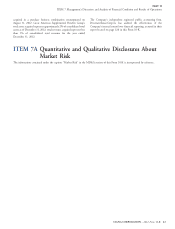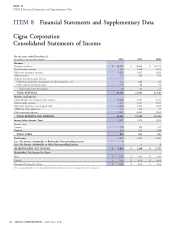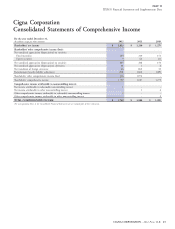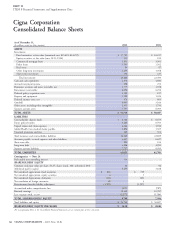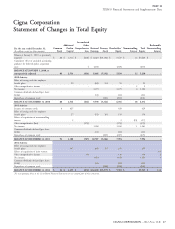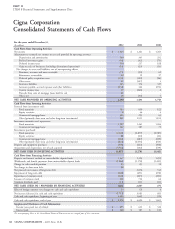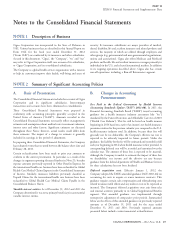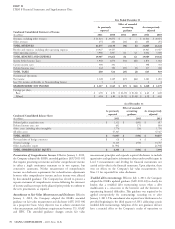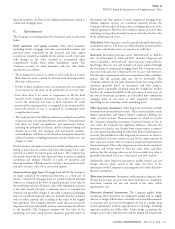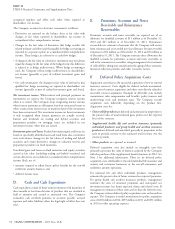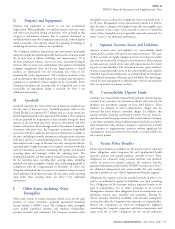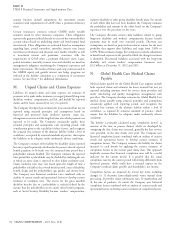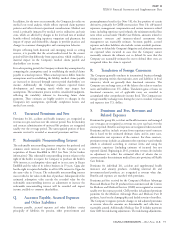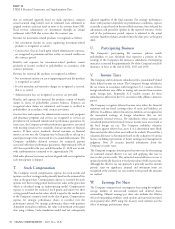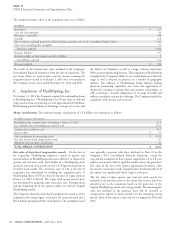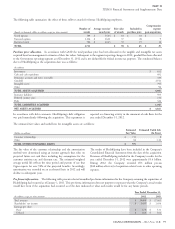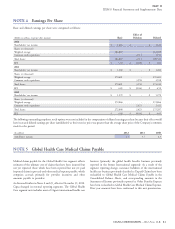Cigna 2012 Annual Report Download - page 93
Download and view the complete annual report
Please find page 93 of the 2012 Cigna annual report below. You can navigate through the pages in the report by either clicking on the pages listed below, or by using the keyword search tool below to find specific information within the annual report.PART II
ITEM 8 Financial Statements and Supplementary Data
financial condition. See Note 12 for additional information related to discounted cash flow analyses. Certain commercial mortgage loans
commercial mortgage loans. without valuation reserves are considered impaired because the
Company will not collect all interest due according to the terms of the
original agreements. However, the Company expects to recover their
C. Investments
remaining carrying value primarily because it is less than the fair value
of the underlying real estate.
The Company’s accounting policies for investment assets are discussed
below: Policy loans. Policy loans are carried at unpaid principal balances plus
accumulated interest. The loans are collateralized by insurance policy
Fixed maturities and equity securities. Most fixed maturities
cash values and therefore have no exposure to credit loss.
(including bonds, mortgage and other asset-backed securities and
preferred stocks redeemable by the investor) and some equity Real estate. Investment real estate can be ‘‘held and used’’ or ‘‘held for
securities are classified as available for sale and are carried at fair value sale’’. As of December 31, 2012 and 2011, all of the Company’s real
with changes in fair value recorded in accumulated other estate is classified as ‘‘held and used’’. Such real estate is expected to be
comprehensive income (loss) within shareholders’ equity. The held longer than one year and includes real estate acquired through
Company accounts for fixed maturities with fair value below the foreclosure of commercial mortgage loans. The Company carries
amortized cost as follows: real estate held and used at depreciated cost less any write-downs to
The Company first assesses its intent to sell or whether it is more fair value due to impairment and assesses impairment when cash flows
likely than not to be required to sell such fixed maturities before indicate that the carrying value may not be recoverable. The
their fair values recover. Company estimates the fair value of impaired real estate using internal
valuations generally based on discounted cash flow analyses.
If either of those conditions is met, an impairment loss is recognized Depreciation is generally calculated using the straight-line method
in net income for the excess of the amortized cost over fair value. based on the estimated useful life of the particular real estate asset. At
Even when there is no intent or requirement to sell the fixed the time of foreclosure, properties are reclassified from commercial
maturity, if the Company determines that it does not expect to mortgage loans to real estate or other long-term investments
recover the amortized cost basis of fixed maturities the credit depending on the ownership of the underlying assets.
portion of the impairment loss is recognized in net income and the Other long-term investments. Other long-term investments include
non-credit portion, if any, is recognized in accumulated other investments in unconsolidated entities. These entities include certain
comprehensive income. limited partnerships and limited liability companies holding real
The credit portion is the difference between amortized cost and the estate, securities or loans. These investments are carried at cost plus
net present value of its projected future cash flows. Projected future the Company’s ownership percentage of reported income or loss in
cash flows are based on qualitative and quantitative factors, cases where the Company has significant influence, otherwise the
including the probability of default, and the estimated timing and investment is carried at cost. Income from certain entities is reported
amount of recovery. For mortgage and asset-backed securities, on a one quarter lag depending on when their financial information is
estimated future cash flows are also based on assumptions about the received. Also included in other long-term investments are loans to
collateral attributes including prepayment speeds, default rates and unconsolidated real estate entities secured by the equity interests of
changes in value. these real estate entities, that are carried at unpaid principal balances
(mezzanine loans). These other long-term investments are considered
Fixed maturities and equity securities also include trading and certain impaired, and written down to their fair value, when cash flows
hybrid securities that are carried at fair value with changes in fair value indicate that the carrying value may not be recoverable. Fair value is
reported in realized investment gains and losses. The Company has generally determined based on a discounted cash flow analysis.
irrevocably elected the fair value option for these securities to simplify
accounting and mitigate volatility in results of operations and Additionally, other long-term investments include interest rate and
financial condition. Hybrid securities include certain preferred stock foreign currency swaps carried at fair value. See Note 13 for
and debt securities with call or conversion options. information on the Company’s accounting policies for these derivative
financial instruments.
Commercial mortgage loans. Mortgage loans held by the Company
are made exclusively to commercial borrowers at a fixed rate of Short-term investments. Investments with maturities of greater than
interest. Commercial mortgage loans are carried at unpaid principal 90 days but less than one year from time of purchase are classified as
balances or, if impaired, the lower of unpaid principal or fair value of short-term, available for sale and carried at fair value, which
the underlying real estate. If the fair value of the underlying real estate approximates cost.
is less than unpaid principal, a valuation reserve is recorded and
Derivative financial instruments. The Company applies hedge
adjusted each period for changes in fair value. Commercial mortgage
accounting when derivatives are designated, qualify and are highly
loans are considered impaired when it is probable that the Company
effective as hedges. Effectiveness is formally assessed and documented
will not collect amounts due according to the terms of the original
at inception and each period throughout the life of a hedge using
loan agreement. The Company monitors credit risk and assesses the
various quantitative methods appropriate for each hedge, including
impairment of loans individually and on a consistent basis for all loans
regression analysis and dollar offset. Under hedge accounting, the
in the portfolio. The Company estimates the fair value of the
changes in fair value of the derivative and the hedged risk are generally
underlying real estate using internal valuations generally based on
CIGNA CORPORATION - 2012 Form 10-K 71
•
•
•
•


